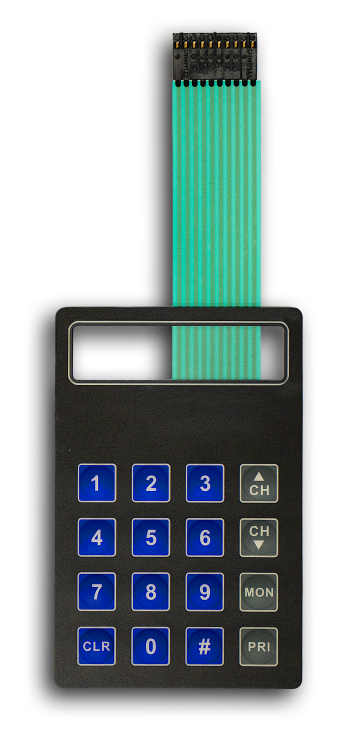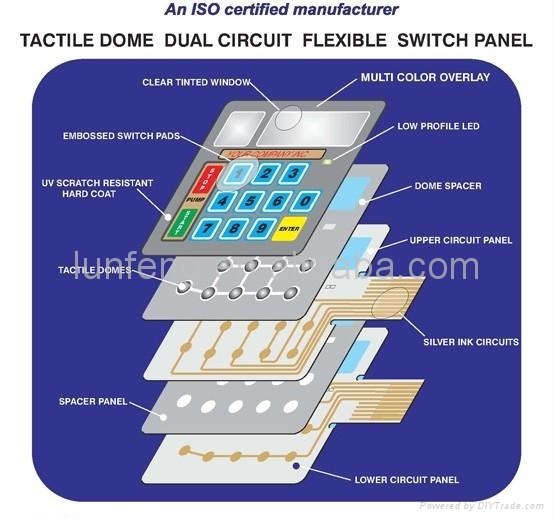Membrane Switches Explained: A Comprehensive Guide to Their Advantages
Membrane layer switches over stand for a functional and advanced option for creating customer interfaces across a variety of fields. As industries increasingly seek efficient and trustworthy control user interfaces, comprehending the specific benefits and applications of membrane layer changes becomes crucial.
What Are Membrane Switches?

When pressure is put on the membrane layer switch, the layers make call, completing an electrical circuit. This straightforward mechanism permits a large range of applications, from customer electronics to commercial machinery. Membrane layer switches are commonly made to be resistant and waterproof to dirt and pollutants, making them appropriate for settings where toughness is important.
Furthermore, the versatility of the products utilized in membrane layer switches facilitates innovative styles that can comply with different forms and measurements. This flexibility adds to their appeal in varied fields, including clinical tools, vehicle controls, and home devices. Generally, membrane layer switches represent a crucial element in modern interface modern technology, linking the void between individuals and digital systems.
Trick Benefits of Membrane Switches
Amongst the myriad of customer interface alternatives readily available, membrane layer changes stick out for their distinct combination of advantages. One of the key advantages is their lightweight and compact layout, which enables combination into a vast array of gadgets without adding significant mass. This is especially beneficial in applications where space is restricted.
Furthermore, membrane switches over deal toughness and resistance to ecological elements. They are generally created with materials that can withstand dampness, dust, and various chemicals, making them ideal for severe problems. This sturdiness contributes to a much longer life expectancy contrasted to standard mechanical switches.
One more significant benefit is the flexibility in modification. Membrane switches can be published with different graphics, shades, and structures, permitting tailored designs that satisfy specific branding or practical needs. This flexibility expands to the number of layers and circuit alternatives, offering designers with numerous configurations.
In addition, the tactile responses offered by some membrane layer switches over enhances user experience, making them a lot more intuitive to run. The convenience of cleansing and maintenance additionally strengthens membrane layer switches as a sensible choice in both consumer and commercial applications. On the whole, these key advantages make them a recommended option for several developers and manufacturers
Applications in Various Industries
Exactly how do membrane switches discover their location across diverse markets? Their flexibility and performance make them important elements in markets varying from medical care to consumer electronics. In clinical tools, membrane layer buttons are made use of for their simplicity of cleansing and resistance to contamination, making certain hygiene in settings where sterility is vital.
In the customer electronics industry, these buttons offer sleek, user-friendly interfaces that enhance item aesthetic appeals while preserving longevity versus deterioration. Automotive applications take advantage of membrane switches too, where they are made use of in control panels and control panels, offering reliable performance in tough problems.
Additionally, industrial machinery uses membrane layer switches for control panels as a result of their toughness, capability to stand up to severe environments, and personalized styles that deal with details functional requirements. The food sector leverages membrane switches for their simplicity of use and resistance to spills, ensuring functional efficiency in busy settings.
Inevitably, the versatility of membrane switches over across these varied applications highlights their essential duty in contemporary technology, improving user useful link interaction while meeting industry-specific needs. Their continued advancement promises additional integration into emerging areas and innovative products.
Layout and Customization Alternatives
The style and modification options readily available for membrane switches are essential for customizing user interfaces to satisfy specific customer needs and aesthetic preferences. These buttons can be created in different forms, sizes, and layouts, permitting smooth assimilation right into diverse applications. The flexibility in design means that suppliers can develop one-of-a-kind interfaces that boost functionality and keep brand identity.
Custom-made shades, textures, and graphics can be put on the surface of the membrane switch, providing an opportunity for branding and customer engagement. Additionally, backlighting choices, such as LED illumination, can be incorporated to boost exposure in low-light problems, hence improving capability.
Useful aspects can also be tailored, consisting of responsive feedback and actuation pressure, which can be adapted to match various individual interactions. The choice of materials, such as polyester or polycarbonate, enables for variations in toughness and environmental resistance, catering to the details demands of different sectors.
Ultimately, the considerable style and modification capabilities of membrane switches allow firms to create easy to use and visually attractive user interfaces, ensuring that their items meet both visual and practical needs successfully. Membrane Switches.
Factors To Consider for Application
Executing membrane layer changes calls for mindful consideration of various factors to guarantee optimal functionality and individual experience. Factors such as exposure to moisture, click this site severe temperatures, and chemical substances can substantially affect the switch's efficiency and durability.

An additional crucial element is the button's design and format. Making certain that the tactile feedback and actuation force align with individual assumptions enhances functionality. Performing individual testing can supply beneficial understandings right into the ideal design.
Additionally, compatibility with digital components must be examined. The button's circuitry should line up with the overall system design, making sure reputable signal transmission and lessening interference.
Moreover, manufacturing techniques and prices must be examined. The choice in between custom designs and common versions can lead and affect both spending plan time.
Finally, take into consideration maintenance and repair. Membrane layer switches may call for specific cleaning and treatment procedures to keep their appearance and functionality with time. By addressing these factors to consider, organizations can implement membrane buttons that fulfill their operational needs while giving a positive individual experience.

Final Thought
In conclusion, membrane changes stand for a functional and durable control interface suitable for a vast range of applications across several official source markets. Membrane Switches. As innovation continues to develop, the relevance of membrane switches in modern devices remains significant, offering both functionality and aesthetic allure.
Membrane changes stand for a sophisticated and functional solution for producing individual interfaces across a variety of markets.Comprehending the essential components of modern-day electronic interfaces, membrane switches are a kind of user interface tool that are composed of adaptable, slim layers of material. On the whole, membrane layer switches represent an essential aspect in modern-day user interface innovation, linking the space between users and electronic systems.
Amongst the myriad of individual interface alternatives offered, membrane switches over stand out for their unique combination of benefits.The layout and customization choices readily available for membrane buttons are essential for customizing user interfaces to meet specific user demands and aesthetic choices.